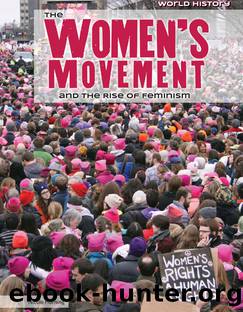The Women's Movement and the Rise of Feminism by Horning Nicole;

Author:Horning, Nicole;
Language: eng
Format: epub
Publisher: Greenhaven Publishing LLC
Union workers marched in demonstrations to honor the victims of the Triangle Shirtwaist Factory fire.
More than 400 women labored in the companyâs 10-story building near Washington Square in New York City. On March 25, a fire started on the eighth floor in a rag bin. The manager attempted to use a hose to put out the fire, but as with other things in the factory, the hose was not in good conditionâit was rotted and the valve was rusted shut. The operational elevator could hold only 12 people, and it made only 4 trips before it broke down. Others were not so lucky. Some tried to escape via the stairs but encountered a locked door and were trapped. Others leaped from windows and fell to their deaths. Many fell on the fire hoses, which made it difficult to begin putting out the fire. A total of 146 workers, almost all women, perished in the disaster. The ensuing public uproar was so great that legislators in New York and other states hastily began creating stricter safety laws for factories and other workplaces.
The Susan B. Anthony Amendment
By the time of the fire and the reforms it inspired, another major goal of the womenâs movementâsuffrageâwas finally making significant headway. By 1911, five statesâUtah, Idaho, Washington, Wyoming, and Coloradoâhad already given women the right to vote. This trend of individual states approving female suffrage, despite the absence of a federal law allowing it, continued. In 1912, Arizona, California, Kansas, and Oregon granted women the right to vote. Two years later, Nevada and Montana followed suit.
Meanwhile, the womenâs rights activists who had lost momentum in the 1870s managed to regain it. In 1890, the American Woman Suffrage Association and the National Woman Suffrage Association agreed to merge. The new group was called the National American Woman Suffrage Association (NAWSA). It stepped up efforts to lobby congressmen to pass a constitutional amendment granting womenâs suffrage. Back in 1878, Susan B. Anthony had managed to get such an amendment introduced in Congress. It had not passed, but the amendment with the unofficial title of the âSusan B. Anthony Amendmentâ was reintroduced nearly every year.
Such efforts did not come without controversy. During these same years, several antiâwomenâs suffrage organizations formed. Their members, men and women alike, were convinced that giving women the right to vote posed serious threats to society. Womenâs studies scholar Kathleen M. Blee explained some of their worries:
[They] maintained that extending the vote to women would reduce the special protections and routes of influence available to women, destroy the family, and increase the number of socialist-leaning voters. These sentiments dove-tailed with the fears of many Southern whites that female suffrage would undermine the [racist] Jim Crow restrictions that effectively [kept] African American voters in the South [from casting their ballots] and the apprehension of industrial and business leaders [that] women would vote in favor of social and political reform and for prohibiting the sale of liquor.42
Although such groups tried their best to discredit women suffragists, the latter forged ahead and continued to call attention to their grievances.
Download
This site does not store any files on its server. We only index and link to content provided by other sites. Please contact the content providers to delete copyright contents if any and email us, we'll remove relevant links or contents immediately.
Fake News and Propaganda by Fiona Young-Brown(339)
The Basics of Organic Chemistry by Clowes Martin;(335)
The Science of Philip Pullman's His Dark Materials by Mary Gribbin(329)
Harry Potter and the Sorcerer's Stone: SparkNotes Literature Guide by SparkNotes(297)
Flowers in the Gutter by K. R. Gaddy(262)
Braiding Sweetgrass for Young Adults by Robin Wall Kimmerer(253)
Super Simple Chemistry by D.K. Publishing(252)
Summary of the Selfish Gene by Readtrepreneur Publishing(249)
Exam Success in Geography for IGCSE & O Level by Unknown(248)
Dark days in Salem: the witchcraft trials by Deborah Kent(238)
JavaScript Coding for Teens: A Beginner's Guide to Developing Websites and Games by Yueh Andrew(237)
The Python Audio Cookbook;Recipes for Audio Scripting with Python by Alexandros Drymonitis(233)
Analysis and Linear Algebra for Finance: Part II by Bookboon.com(225)
Key Immigration Laws by Kathryn Ohnaka(221)
Cracking the AP Economics Macro & Micro Exams, 2017 Edition by Princeton Review(212)
The Science of Fashion by Julie Danneberg;(204)
Solutions for a Cleaner, Greener Planet: Environmental Chemistry by Marc Zimmer(201)
Reverse Engineering For Everyone! by mytechnotalent(194)
Cracking the AP Psychology Exam, 2017 Edition by Princeton Review(191)
